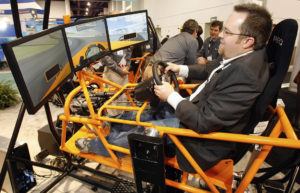The Experiential Explosion—More Companies Realizing the Return on Engagement
 Experiential marketing is having a moment—one that shows no signs of stopping. In a survey by Event Marketing Institute, 79 percent of Fortune 1000 brands surveyed said they planned to execute more experiential programs year over year, and budgets increased an average of 6.1 percent. That’s triple the growth of annual retail sales.
Experiential marketing is having a moment—one that shows no signs of stopping. In a survey by Event Marketing Institute, 79 percent of Fortune 1000 brands surveyed said they planned to execute more experiential programs year over year, and budgets increased an average of 6.1 percent. That’s triple the growth of annual retail sales.
Why the increased interest and investment in experiential marketing? The growth of digital content—and the decrease in our attention spans that has resulted—plays a significant role, says Ryan Dee, Senior Account Executive for Interactions. “All research points to the fact that we are in a stage of our digital evolution where we have reached maximum capacity. There’s so much content out there now, traditional forms of advertising no longer have the same effect. Today, for consumers to stop and really pay attention, the content or message has to be incredibly compelling.”
That’s where events come in. “Through human-to-human interaction, experiential marketing events are able to break through the advertising malaise to actively engage with consumers and create brand affinity,” says Dee. Research from Event Marketing Institute backs shows the same trend—87 percent of consumers say live marketing events are more effective than TV commercials and 98 percent are more likely to buy a product after experiencing it.
Not only is the use of experiential marketing expanding, events are getting ever-more creative. Take the recent flash mob performance Interactions recently executed for a retail store grand opening. Brand Ambassadors dressed as regular shoppers excited and delighted the real shoppers by breaking into song and dance in the middle of the store.
“That’s the type of event that stops shoppers in their tracks,” says Dee. “If you’re looking at your phone and people start singing and dancing around you, you either put down your phone to watch or you start taking a video of them and creating content of your own.” This, in turn, often turns shoppers into champions of the brand, sharing their experiences with friends and family members.
To be clear, it’s not just retailers who can (and are) benefitting from experiential marketing. Any business with a product or a service can use experiential. “Sign spinners engaging passersby to visit a local tax preparation firm, an immersive tradeshow event for an auto maker, a fashion show that brings to life trends from the pages of a magazine—there’s something for everyone.”
Dee also points out that events don’t have to be grand productions to make an impact. “It’s a common misconception that experiential is expensive but it doesn’t have to be,” he explains. “We’ve worked with budgets small and large, ranging from hundreds of dollars to six figures. Even something as simple as a product demonstration can be very effective. A well-trained and knowledgeable Brand Ambassador can bring a product or service to life for consumers in a way that traditional forms of media simply cannot.”
To learn more about putting experiential to work for your brand, contact Lindsay Steller, Director of Sales and Marketing, at lsteller@interactionsmarketing.com

